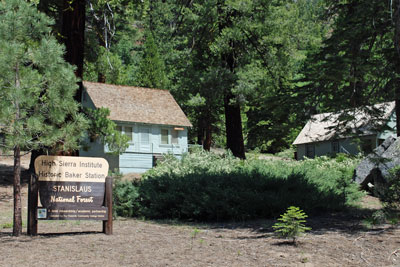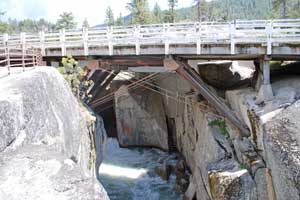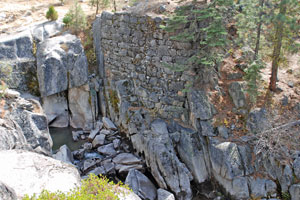Early Settlements along the Sonora Pass Highway
Williams Ranch - Twain Harte
Among the earliest settlers in the Twain Harte area was the Calvin J. Williams family. Calvin, his wife Ann and four children crossed the emigrant trail over Sonora Pass by wagon in 1853.
In 1854 Calvin claimed land along upper Sullivan Creek and gradually expanded his holdings to include what was known as the Bald Rock Ranch. Today Bald Rock pokes up out of Twain Harte Lake. A few old farm houses from the 19th century can still be seen about the Twain Harte area.
Confidence Mine
The Confidence Mine, located just across Highway 108 from the site of the old Confidence Inn, was first discovered in 1856, but it wasn't until the 1860s that the extent of the gold strike was appreciated and quartz mining began in earnest. An incline shafts 1000 feet deep was excavated, and 2000 of tunnels were extended underground. Millions of dollars in gold were extracted from the mine. Other mines nearby made Confidence a booming mining region in the 1860s.
Excelsior Hotel
The Excelsior Hotel in Sugarpine was a popular gathering place for travelers and campers in the latter half of the 19th century. Established by Thomas J. Northrup in the 1860s, the hotel stood for years at the side of the wagon road. A historical marker in Sugarpine near the fire station indicates the general location of the hotel.
Strawberry
Strawberry was a popular mountain retreat during the 19th century. Residents of lower elevations flocked to Strawberry during the summer months to escape the heat, to hunt and fish, and to enjoy the companionship of camping together in large groups. John McDonald may have operated the first resort at Strawberry, but he soon sold it to James Allen. Ed Parsons and his wife became the proprietors in 1886 and developed the resort as the premier retreat on Sonora Pass for decades to follow. The resort was owned by the Conlin family during the first half of the 20th century. The two-story resort burned in the 1940s.
Leland Meadow
Leland Meadow was claimed as pasture land by Gustavus Adolphus Leland, a baker and farmer from Jamestown, and his wife Frances. Gustavus and Frances raised eight children in Jamestown. Some old farm buildings still stand at the meadow that bears their name. Today the area has been turned into a winter snow play area.
Eureka Valley
In Eureka Valley, ½ mile east of the Eureka Valley Campground, a plaque commemorates the road house established by David Hayes and Jack Welch in 1864-1865 during the boom days of the Sonora and Mono Wagon Road. The building stood in the clearing and served as a stopping place for travelers. The building was constructed from hewn logs with mortised corners. Hayes and friends were known to winter there on occasion.
TOP
Douglas Station
The old Douglas Resort once occupied the land across the road from the Douglas Picnic Area. The resort was built in the 1920s. The main building contained a dining room and kitchen. Guests slept in tents, which rented for $1 a day. Scenes for the old movie Robin Hood of El Dorado were filmed near the resort.
Baker Station

In the 1880s Greenbury C. Baker from Sonora opened what he described as a "Summer Resort" at Baker's Station, just a half mile back down the highway from the Kennedy Meadows turnoff. Baker offered accommodations to individuals or families for a day, a week, or a month. The hostelry was used mostly by people crossing the pass on the wagon road.
By 1890 snow had collapsed the original buildings. Later the site was turned into a highway maintenance station. Today Baker's Station is used by the High Sierra Institute in partnership with Columbia College. The Institute has hosted classes such as ornithology, nature photography, and ecological restoration.
Leavitt Meadow Hostelry
In the 1860s when the wagon road first opened, Hiram Leavitt brought his family over Sonora Pass and established a small hotel on the bank of the river in Leavitt Meadow. A marker notes the historic site, but there is virtually nothing to be seen there today. Eventually Leavitt tired of running the way station and moved his family to Bridgeport.





